Organizations and Behavior Report: Leadership Styles and Impact
VerifiedAdded on 2020/02/03
|14
|4219
|256
Report
AI Summary
This report provides a comprehensive analysis of organizational behavior, covering various aspects such as organizational structures, leadership styles, and management practices. It begins by comparing functional, divisional, and matrix organizational structures, highlighting their benefits and drawbacks. The report then explores the impact of these structures on business performance, emphasizing the importance of formal and informal employee behavior. Factors influencing individual organizational behavior, including abilities, gender, and culture, are also discussed. Furthermore, the report delves into different leadership styles—autocratic, democratic, and laissez-faire—and examines their application within organizations. It also explores management practices, organizational theory, and the differences in management approaches between public and private sectors. The impact of leadership styles and the application of motivational theories in the workplace are also analyzed, along with the nature of groups and their behavior, factors contributing to effective teamwork, and the impact of team functioning on organizational outcomes. The report concludes with a summary of the key findings and insights.
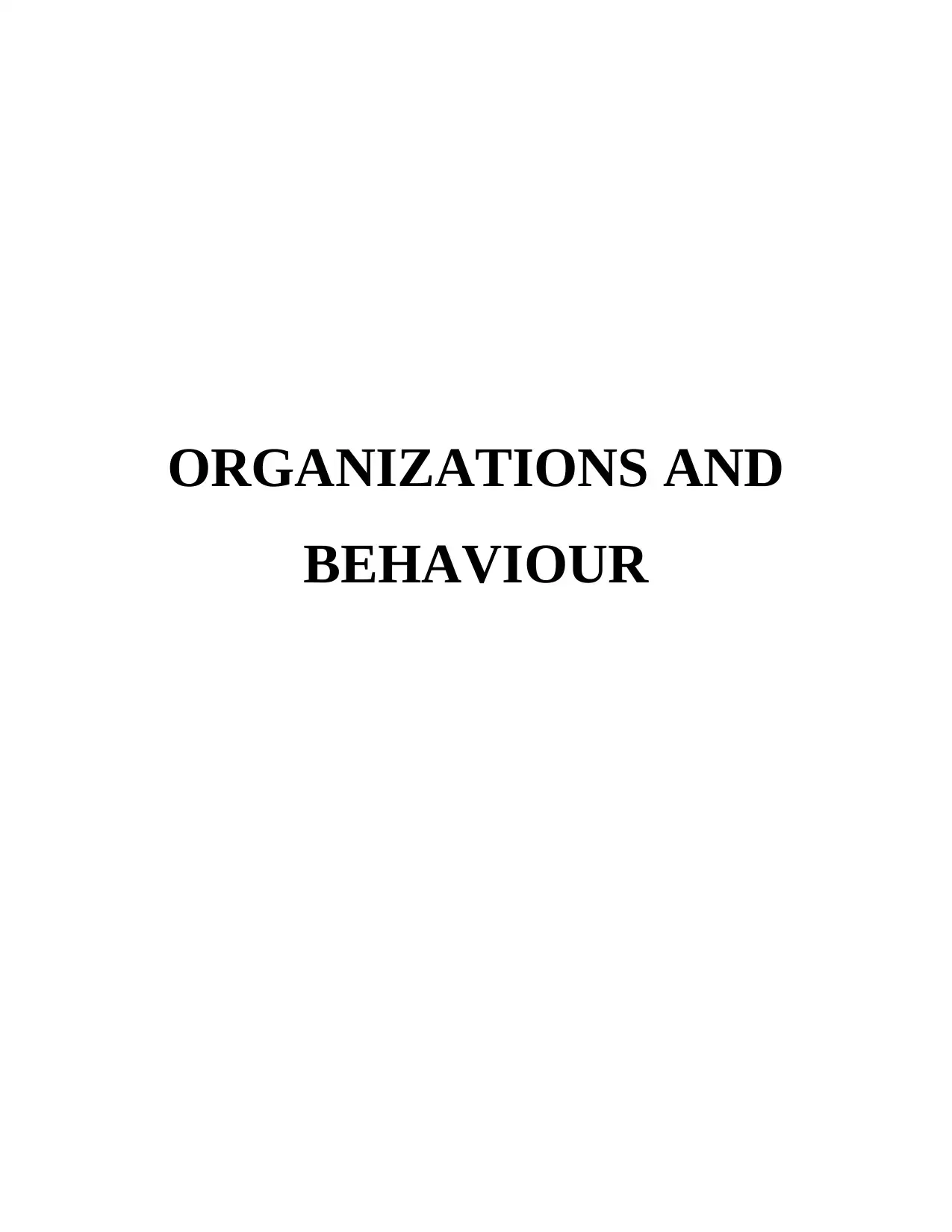
ORGANIZATIONS AND
BEHAVIOUR
BEHAVIOUR
Paraphrase This Document
Need a fresh take? Get an instant paraphrase of this document with our AI Paraphraser
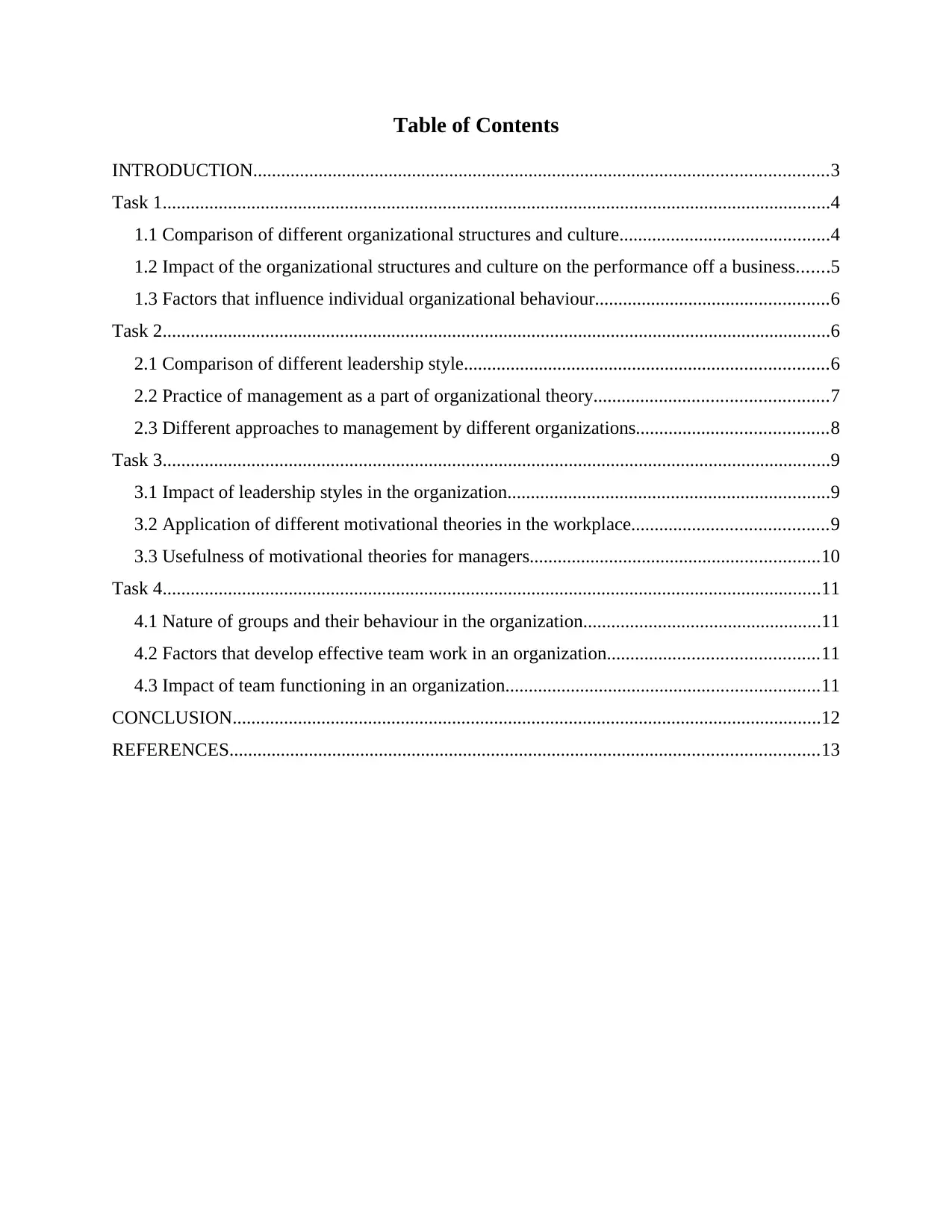
Table of Contents
INTRODUCTION...........................................................................................................................3
Task 1...............................................................................................................................................4
1.1 Comparison of different organizational structures and culture.............................................4
1.2 Impact of the organizational structures and culture on the performance off a business.......5
1.3 Factors that influence individual organizational behaviour..................................................6
Task 2...............................................................................................................................................6
2.1 Comparison of different leadership style..............................................................................6
2.2 Practice of management as a part of organizational theory..................................................7
2.3 Different approaches to management by different organizations.........................................8
Task 3...............................................................................................................................................9
3.1 Impact of leadership styles in the organization.....................................................................9
3.2 Application of different motivational theories in the workplace..........................................9
3.3 Usefulness of motivational theories for managers..............................................................10
Task 4.............................................................................................................................................11
4.1 Nature of groups and their behaviour in the organization...................................................11
4.2 Factors that develop effective team work in an organization.............................................11
4.3 Impact of team functioning in an organization...................................................................11
CONCLUSION..............................................................................................................................12
REFERENCES..............................................................................................................................13
INTRODUCTION...........................................................................................................................3
Task 1...............................................................................................................................................4
1.1 Comparison of different organizational structures and culture.............................................4
1.2 Impact of the organizational structures and culture on the performance off a business.......5
1.3 Factors that influence individual organizational behaviour..................................................6
Task 2...............................................................................................................................................6
2.1 Comparison of different leadership style..............................................................................6
2.2 Practice of management as a part of organizational theory..................................................7
2.3 Different approaches to management by different organizations.........................................8
Task 3...............................................................................................................................................9
3.1 Impact of leadership styles in the organization.....................................................................9
3.2 Application of different motivational theories in the workplace..........................................9
3.3 Usefulness of motivational theories for managers..............................................................10
Task 4.............................................................................................................................................11
4.1 Nature of groups and their behaviour in the organization...................................................11
4.2 Factors that develop effective team work in an organization.............................................11
4.3 Impact of team functioning in an organization...................................................................11
CONCLUSION..............................................................................................................................12
REFERENCES..............................................................................................................................13
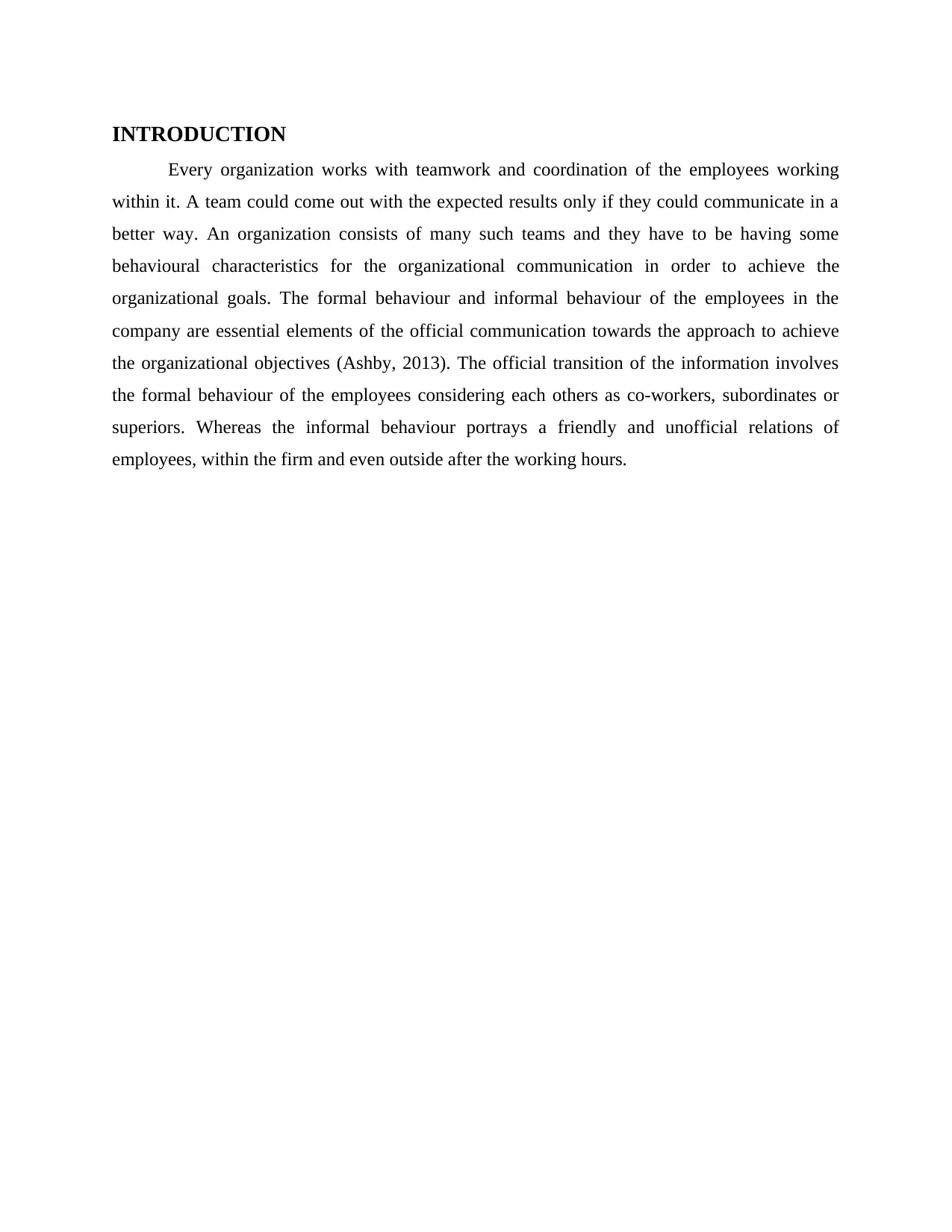
INTRODUCTION
Every organization works with teamwork and coordination of the employees working
within it. A team could come out with the expected results only if they could communicate in a
better way. An organization consists of many such teams and they have to be having some
behavioural characteristics for the organizational communication in order to achieve the
organizational goals. The formal behaviour and informal behaviour of the employees in the
company are essential elements of the official communication towards the approach to achieve
the organizational objectives (Ashby, 2013). The official transition of the information involves
the formal behaviour of the employees considering each others as co-workers, subordinates or
superiors. Whereas the informal behaviour portrays a friendly and unofficial relations of
employees, within the firm and even outside after the working hours.
Every organization works with teamwork and coordination of the employees working
within it. A team could come out with the expected results only if they could communicate in a
better way. An organization consists of many such teams and they have to be having some
behavioural characteristics for the organizational communication in order to achieve the
organizational goals. The formal behaviour and informal behaviour of the employees in the
company are essential elements of the official communication towards the approach to achieve
the organizational objectives (Ashby, 2013). The official transition of the information involves
the formal behaviour of the employees considering each others as co-workers, subordinates or
superiors. Whereas the informal behaviour portrays a friendly and unofficial relations of
employees, within the firm and even outside after the working hours.
⊘ This is a preview!⊘
Do you want full access?
Subscribe today to unlock all pages.

Trusted by 1+ million students worldwide

Task 1
1.1 Comparison of different organizational structures and culture
The table below will clearly distinguish the factors of difference in the three different
organizational structures:
Basis Functional Divisional Matrix
Basic Form The employees are
organized into
departments on the
functional basis on
which they perform in
the company.
It structures the
employees on the base
of the product or
service produced by
the organization, the
area of which the
market is handled by
them or the specific
customer section or
market focused on.
This structure of
organizational
behaviour is a hybrid
of both the divisional
and functional
structure, creating
effective and
independent units of
business for every
particular market that
is targeted or each
services and product
produced by the
company.
Benefits Employees working
within the functional
structure will be
supporting and
enhancing each other's
knowledge in every
function. This type of
structuring may create
greater capabilities and
scale economies.
The divisional
structure is mostly
decentralized, enabling
flexibility at a higher
level when in reaction
with external market
forces.
The matrix structure
will be in attempt for
the advantages of both
the functional and
divisional structures to
be attained.
1.1 Comparison of different organizational structures and culture
The table below will clearly distinguish the factors of difference in the three different
organizational structures:
Basis Functional Divisional Matrix
Basic Form The employees are
organized into
departments on the
functional basis on
which they perform in
the company.
It structures the
employees on the base
of the product or
service produced by
the organization, the
area of which the
market is handled by
them or the specific
customer section or
market focused on.
This structure of
organizational
behaviour is a hybrid
of both the divisional
and functional
structure, creating
effective and
independent units of
business for every
particular market that
is targeted or each
services and product
produced by the
company.
Benefits Employees working
within the functional
structure will be
supporting and
enhancing each other's
knowledge in every
function. This type of
structuring may create
greater capabilities and
scale economies.
The divisional
structure is mostly
decentralized, enabling
flexibility at a higher
level when in reaction
with external market
forces.
The matrix structure
will be in attempt for
the advantages of both
the functional and
divisional structures to
be attained.
Paraphrase This Document
Need a fresh take? Get an instant paraphrase of this document with our AI Paraphraser
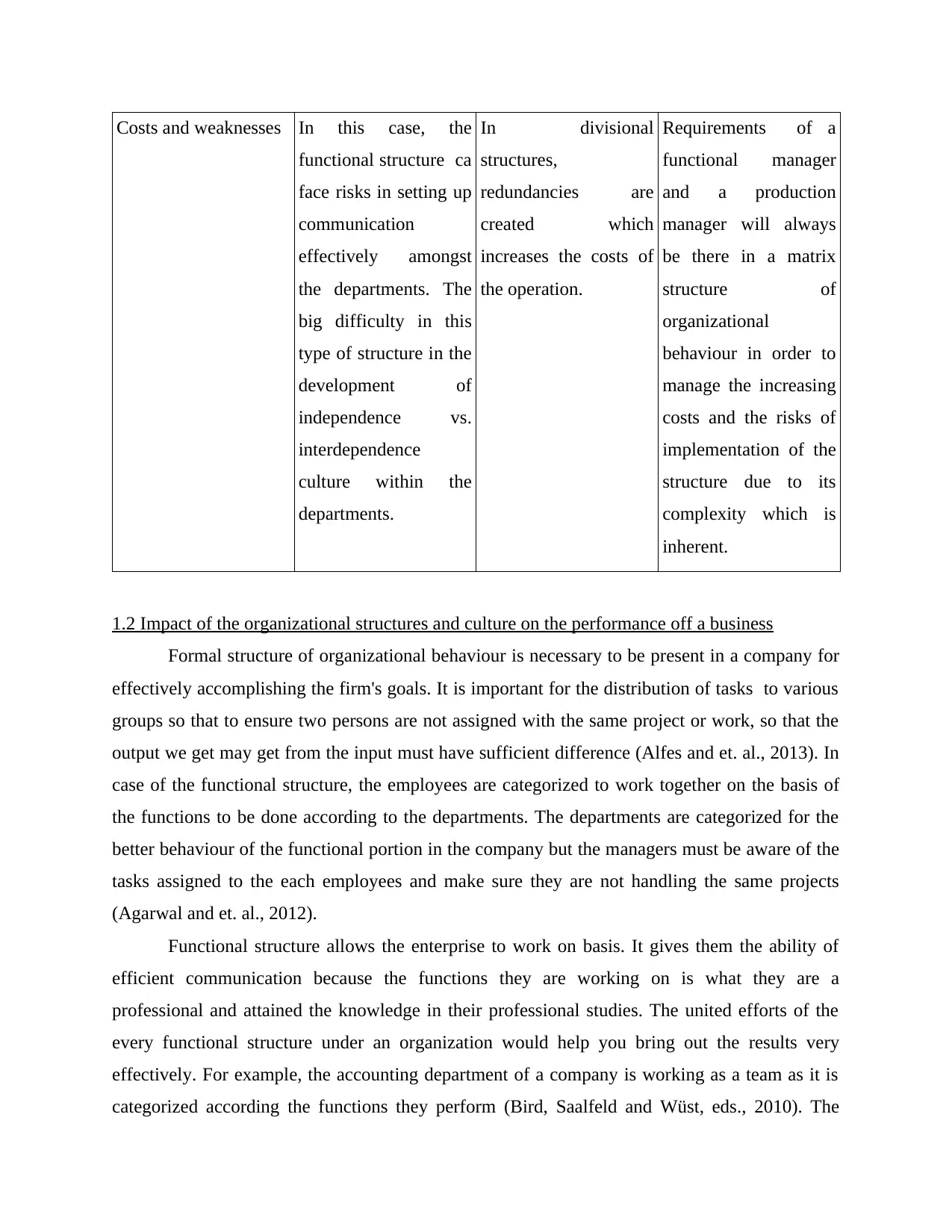
Costs and weaknesses In this case, the
functional structure ca
face risks in setting up
communication
effectively amongst
the departments. The
big difficulty in this
type of structure in the
development of
independence vs.
interdependence
culture within the
departments.
In divisional
structures,
redundancies are
created which
increases the costs of
the operation.
Requirements of a
functional manager
and a production
manager will always
be there in a matrix
structure of
organizational
behaviour in order to
manage the increasing
costs and the risks of
implementation of the
structure due to its
complexity which is
inherent.
1.2 Impact of the organizational structures and culture on the performance off a business
Formal structure of organizational behaviour is necessary to be present in a company for
effectively accomplishing the firm's goals. It is important for the distribution of tasks to various
groups so that to ensure two persons are not assigned with the same project or work, so that the
output we get may get from the input must have sufficient difference (Alfes and et. al., 2013). In
case of the functional structure, the employees are categorized to work together on the basis of
the functions to be done according to the departments. The departments are categorized for the
better behaviour of the functional portion in the company but the managers must be aware of the
tasks assigned to the each employees and make sure they are not handling the same projects
(Agarwal and et. al., 2012).
Functional structure allows the enterprise to work on basis. It gives them the ability of
efficient communication because the functions they are working on is what they are a
professional and attained the knowledge in their professional studies. The united efforts of the
every functional structure under an organization would help you bring out the results very
effectively. For example, the accounting department of a company is working as a team as it is
categorized according the functions they perform (Bird, Saalfeld and Wüst, eds., 2010). The
functional structure ca
face risks in setting up
communication
effectively amongst
the departments. The
big difficulty in this
type of structure in the
development of
independence vs.
interdependence
culture within the
departments.
In divisional
structures,
redundancies are
created which
increases the costs of
the operation.
Requirements of a
functional manager
and a production
manager will always
be there in a matrix
structure of
organizational
behaviour in order to
manage the increasing
costs and the risks of
implementation of the
structure due to its
complexity which is
inherent.
1.2 Impact of the organizational structures and culture on the performance off a business
Formal structure of organizational behaviour is necessary to be present in a company for
effectively accomplishing the firm's goals. It is important for the distribution of tasks to various
groups so that to ensure two persons are not assigned with the same project or work, so that the
output we get may get from the input must have sufficient difference (Alfes and et. al., 2013). In
case of the functional structure, the employees are categorized to work together on the basis of
the functions to be done according to the departments. The departments are categorized for the
better behaviour of the functional portion in the company but the managers must be aware of the
tasks assigned to the each employees and make sure they are not handling the same projects
(Agarwal and et. al., 2012).
Functional structure allows the enterprise to work on basis. It gives them the ability of
efficient communication because the functions they are working on is what they are a
professional and attained the knowledge in their professional studies. The united efforts of the
every functional structure under an organization would help you bring out the results very
effectively. For example, the accounting department of a company is working as a team as it is
categorized according the functions they perform (Bird, Saalfeld and Wüst, eds., 2010). The
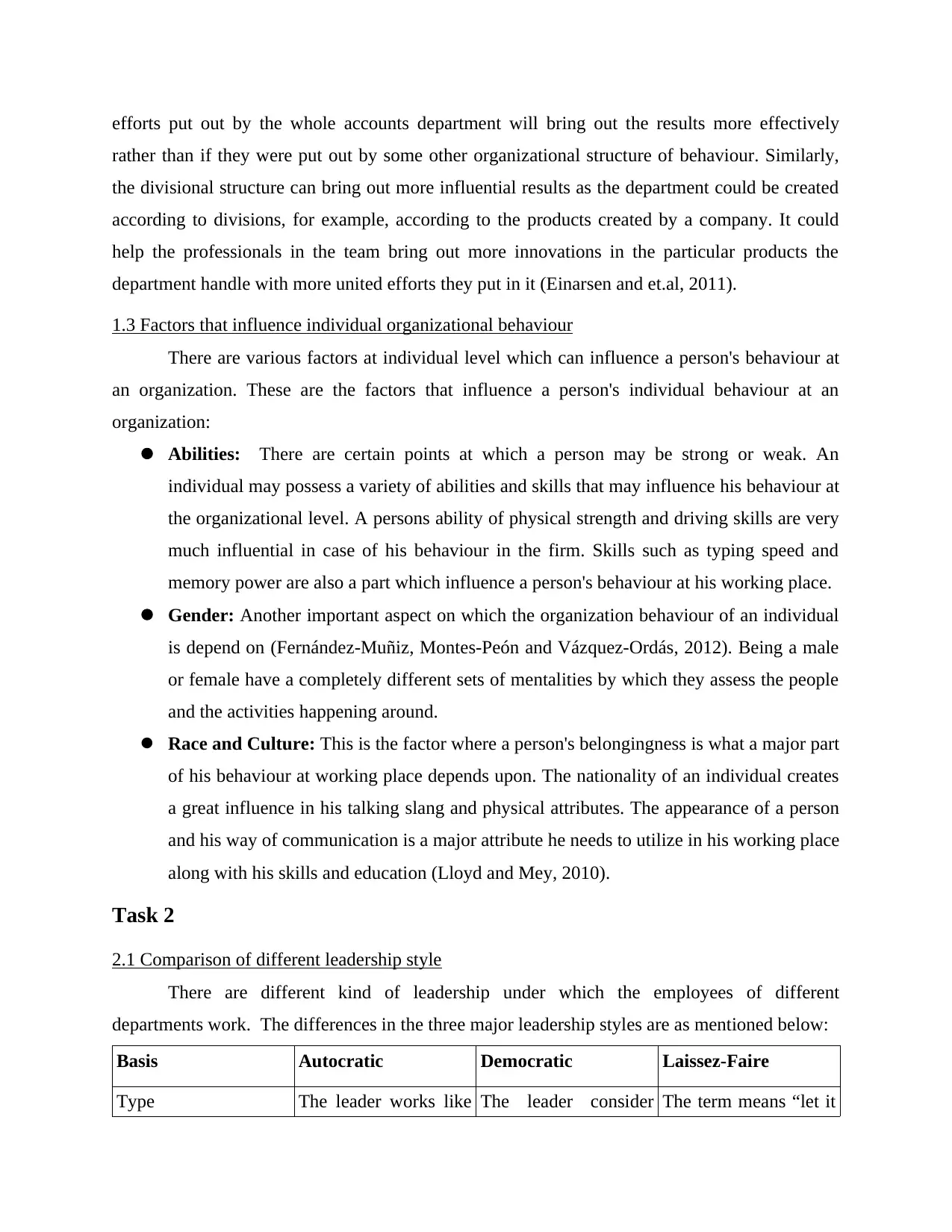
efforts put out by the whole accounts department will bring out the results more effectively
rather than if they were put out by some other organizational structure of behaviour. Similarly,
the divisional structure can bring out more influential results as the department could be created
according to divisions, for example, according to the products created by a company. It could
help the professionals in the team bring out more innovations in the particular products the
department handle with more united efforts they put in it (Einarsen and et.al, 2011).
1.3 Factors that influence individual organizational behaviour
There are various factors at individual level which can influence a person's behaviour at
an organization. These are the factors that influence a person's individual behaviour at an
organization:
Abilities: There are certain points at which a person may be strong or weak. An
individual may possess a variety of abilities and skills that may influence his behaviour at
the organizational level. A persons ability of physical strength and driving skills are very
much influential in case of his behaviour in the firm. Skills such as typing speed and
memory power are also a part which influence a person's behaviour at his working place.
Gender: Another important aspect on which the organization behaviour of an individual
is depend on (Fernández-Muñiz, Montes-Peón and Vázquez-Ordás, 2012). Being a male
or female have a completely different sets of mentalities by which they assess the people
and the activities happening around.
Race and Culture: This is the factor where a person's belongingness is what a major part
of his behaviour at working place depends upon. The nationality of an individual creates
a great influence in his talking slang and physical attributes. The appearance of a person
and his way of communication is a major attribute he needs to utilize in his working place
along with his skills and education (Lloyd and Mey, 2010).
Task 2
2.1 Comparison of different leadership style
There are different kind of leadership under which the employees of different
departments work. The differences in the three major leadership styles are as mentioned below:
Basis Autocratic Democratic Laissez-Faire
Type The leader works like The leader consider The term means “let it
rather than if they were put out by some other organizational structure of behaviour. Similarly,
the divisional structure can bring out more influential results as the department could be created
according to divisions, for example, according to the products created by a company. It could
help the professionals in the team bring out more innovations in the particular products the
department handle with more united efforts they put in it (Einarsen and et.al, 2011).
1.3 Factors that influence individual organizational behaviour
There are various factors at individual level which can influence a person's behaviour at
an organization. These are the factors that influence a person's individual behaviour at an
organization:
Abilities: There are certain points at which a person may be strong or weak. An
individual may possess a variety of abilities and skills that may influence his behaviour at
the organizational level. A persons ability of physical strength and driving skills are very
much influential in case of his behaviour in the firm. Skills such as typing speed and
memory power are also a part which influence a person's behaviour at his working place.
Gender: Another important aspect on which the organization behaviour of an individual
is depend on (Fernández-Muñiz, Montes-Peón and Vázquez-Ordás, 2012). Being a male
or female have a completely different sets of mentalities by which they assess the people
and the activities happening around.
Race and Culture: This is the factor where a person's belongingness is what a major part
of his behaviour at working place depends upon. The nationality of an individual creates
a great influence in his talking slang and physical attributes. The appearance of a person
and his way of communication is a major attribute he needs to utilize in his working place
along with his skills and education (Lloyd and Mey, 2010).
Task 2
2.1 Comparison of different leadership style
There are different kind of leadership under which the employees of different
departments work. The differences in the three major leadership styles are as mentioned below:
Basis Autocratic Democratic Laissez-Faire
Type The leader works like The leader consider The term means “let it
⊘ This is a preview!⊘
Do you want full access?
Subscribe today to unlock all pages.

Trusted by 1+ million students worldwide
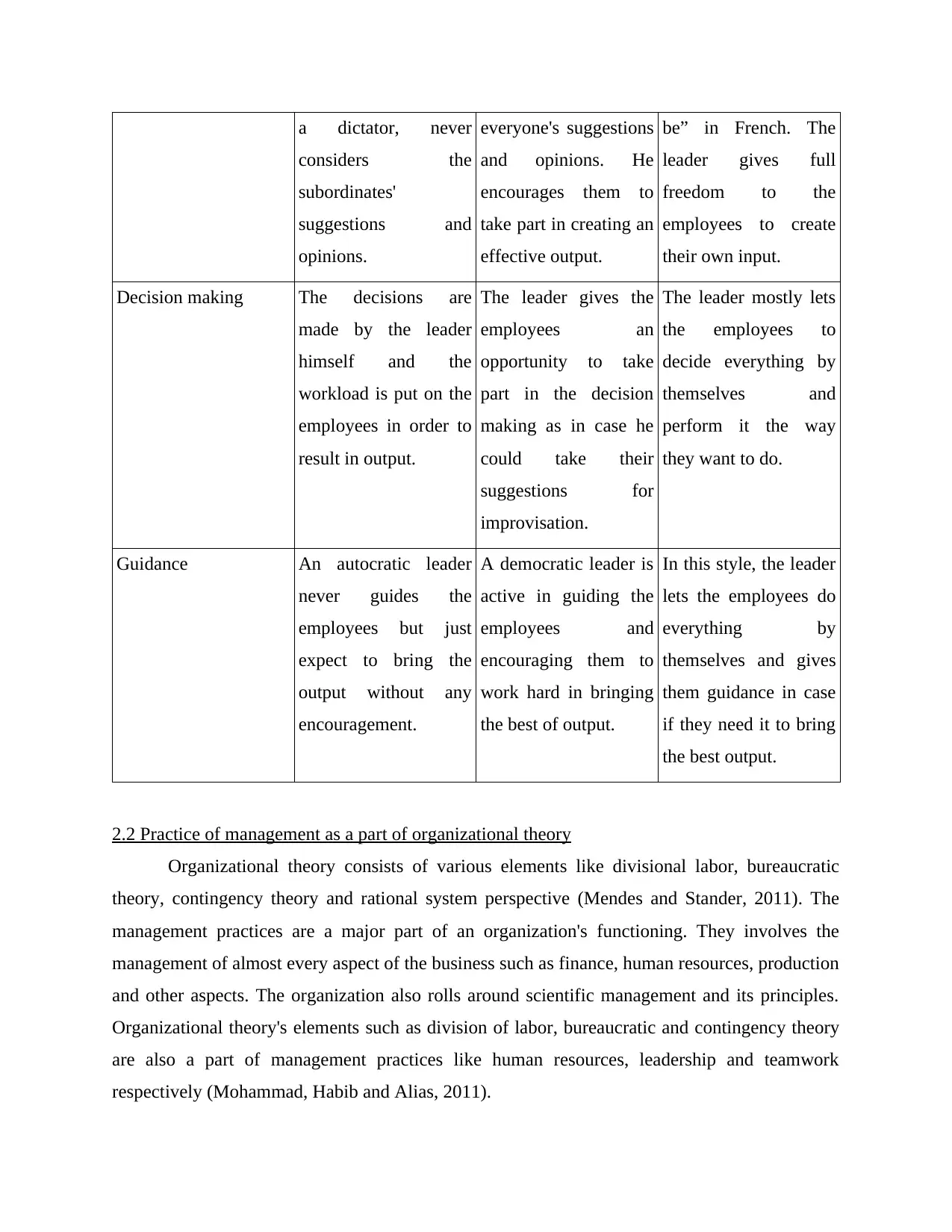
a dictator, never
considers the
subordinates'
suggestions and
opinions.
everyone's suggestions
and opinions. He
encourages them to
take part in creating an
effective output.
be” in French. The
leader gives full
freedom to the
employees to create
their own input.
Decision making The decisions are
made by the leader
himself and the
workload is put on the
employees in order to
result in output.
The leader gives the
employees an
opportunity to take
part in the decision
making as in case he
could take their
suggestions for
improvisation.
The leader mostly lets
the employees to
decide everything by
themselves and
perform it the way
they want to do.
Guidance An autocratic leader
never guides the
employees but just
expect to bring the
output without any
encouragement.
A democratic leader is
active in guiding the
employees and
encouraging them to
work hard in bringing
the best of output.
In this style, the leader
lets the employees do
everything by
themselves and gives
them guidance in case
if they need it to bring
the best output.
2.2 Practice of management as a part of organizational theory
Organizational theory consists of various elements like divisional labor, bureaucratic
theory, contingency theory and rational system perspective (Mendes and Stander, 2011). The
management practices are a major part of an organization's functioning. They involves the
management of almost every aspect of the business such as finance, human resources, production
and other aspects. The organization also rolls around scientific management and its principles.
Organizational theory's elements such as division of labor, bureaucratic and contingency theory
are also a part of management practices like human resources, leadership and teamwork
respectively (Mohammad, Habib and Alias, 2011).
considers the
subordinates'
suggestions and
opinions.
everyone's suggestions
and opinions. He
encourages them to
take part in creating an
effective output.
be” in French. The
leader gives full
freedom to the
employees to create
their own input.
Decision making The decisions are
made by the leader
himself and the
workload is put on the
employees in order to
result in output.
The leader gives the
employees an
opportunity to take
part in the decision
making as in case he
could take their
suggestions for
improvisation.
The leader mostly lets
the employees to
decide everything by
themselves and
perform it the way
they want to do.
Guidance An autocratic leader
never guides the
employees but just
expect to bring the
output without any
encouragement.
A democratic leader is
active in guiding the
employees and
encouraging them to
work hard in bringing
the best of output.
In this style, the leader
lets the employees do
everything by
themselves and gives
them guidance in case
if they need it to bring
the best output.
2.2 Practice of management as a part of organizational theory
Organizational theory consists of various elements like divisional labor, bureaucratic
theory, contingency theory and rational system perspective (Mendes and Stander, 2011). The
management practices are a major part of an organization's functioning. They involves the
management of almost every aspect of the business such as finance, human resources, production
and other aspects. The organization also rolls around scientific management and its principles.
Organizational theory's elements such as division of labor, bureaucratic and contingency theory
are also a part of management practices like human resources, leadership and teamwork
respectively (Mohammad, Habib and Alias, 2011).
Paraphrase This Document
Need a fresh take? Get an instant paraphrase of this document with our AI Paraphraser
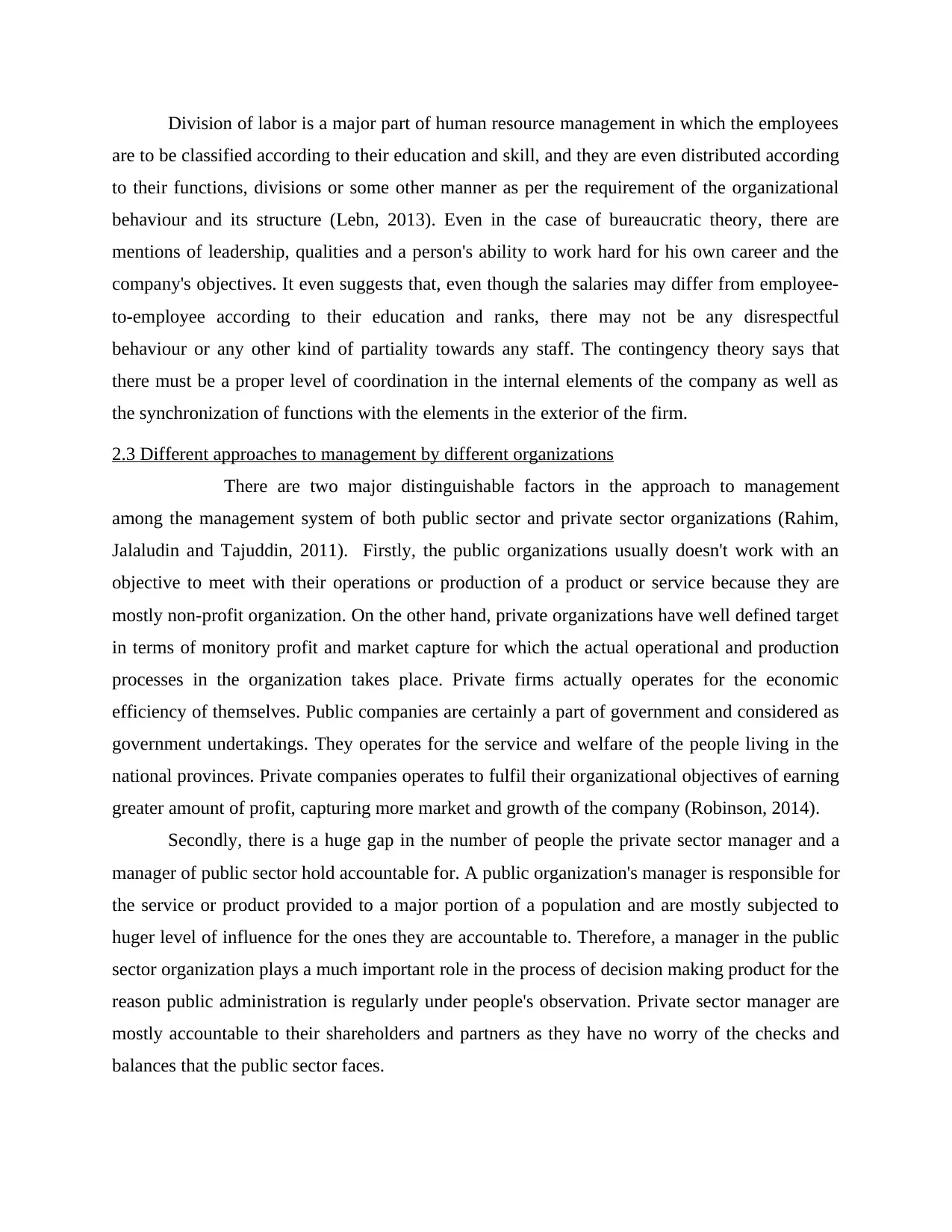
Division of labor is a major part of human resource management in which the employees
are to be classified according to their education and skill, and they are even distributed according
to their functions, divisions or some other manner as per the requirement of the organizational
behaviour and its structure (Lebn, 2013). Even in the case of bureaucratic theory, there are
mentions of leadership, qualities and a person's ability to work hard for his own career and the
company's objectives. It even suggests that, even though the salaries may differ from employee-
to-employee according to their education and ranks, there may not be any disrespectful
behaviour or any other kind of partiality towards any staff. The contingency theory says that
there must be a proper level of coordination in the internal elements of the company as well as
the synchronization of functions with the elements in the exterior of the firm.
2.3 Different approaches to management by different organizations
There are two major distinguishable factors in the approach to management
among the management system of both public sector and private sector organizations (Rahim,
Jalaludin and Tajuddin, 2011). Firstly, the public organizations usually doesn't work with an
objective to meet with their operations or production of a product or service because they are
mostly non-profit organization. On the other hand, private organizations have well defined target
in terms of monitory profit and market capture for which the actual operational and production
processes in the organization takes place. Private firms actually operates for the economic
efficiency of themselves. Public companies are certainly a part of government and considered as
government undertakings. They operates for the service and welfare of the people living in the
national provinces. Private companies operates to fulfil their organizational objectives of earning
greater amount of profit, capturing more market and growth of the company (Robinson, 2014).
Secondly, there is a huge gap in the number of people the private sector manager and a
manager of public sector hold accountable for. A public organization's manager is responsible for
the service or product provided to a major portion of a population and are mostly subjected to
huger level of influence for the ones they are accountable to. Therefore, a manager in the public
sector organization plays a much important role in the process of decision making product for the
reason public administration is regularly under people's observation. Private sector manager are
mostly accountable to their shareholders and partners as they have no worry of the checks and
balances that the public sector faces.
are to be classified according to their education and skill, and they are even distributed according
to their functions, divisions or some other manner as per the requirement of the organizational
behaviour and its structure (Lebn, 2013). Even in the case of bureaucratic theory, there are
mentions of leadership, qualities and a person's ability to work hard for his own career and the
company's objectives. It even suggests that, even though the salaries may differ from employee-
to-employee according to their education and ranks, there may not be any disrespectful
behaviour or any other kind of partiality towards any staff. The contingency theory says that
there must be a proper level of coordination in the internal elements of the company as well as
the synchronization of functions with the elements in the exterior of the firm.
2.3 Different approaches to management by different organizations
There are two major distinguishable factors in the approach to management
among the management system of both public sector and private sector organizations (Rahim,
Jalaludin and Tajuddin, 2011). Firstly, the public organizations usually doesn't work with an
objective to meet with their operations or production of a product or service because they are
mostly non-profit organization. On the other hand, private organizations have well defined target
in terms of monitory profit and market capture for which the actual operational and production
processes in the organization takes place. Private firms actually operates for the economic
efficiency of themselves. Public companies are certainly a part of government and considered as
government undertakings. They operates for the service and welfare of the people living in the
national provinces. Private companies operates to fulfil their organizational objectives of earning
greater amount of profit, capturing more market and growth of the company (Robinson, 2014).
Secondly, there is a huge gap in the number of people the private sector manager and a
manager of public sector hold accountable for. A public organization's manager is responsible for
the service or product provided to a major portion of a population and are mostly subjected to
huger level of influence for the ones they are accountable to. Therefore, a manager in the public
sector organization plays a much important role in the process of decision making product for the
reason public administration is regularly under people's observation. Private sector manager are
mostly accountable to their shareholders and partners as they have no worry of the checks and
balances that the public sector faces.
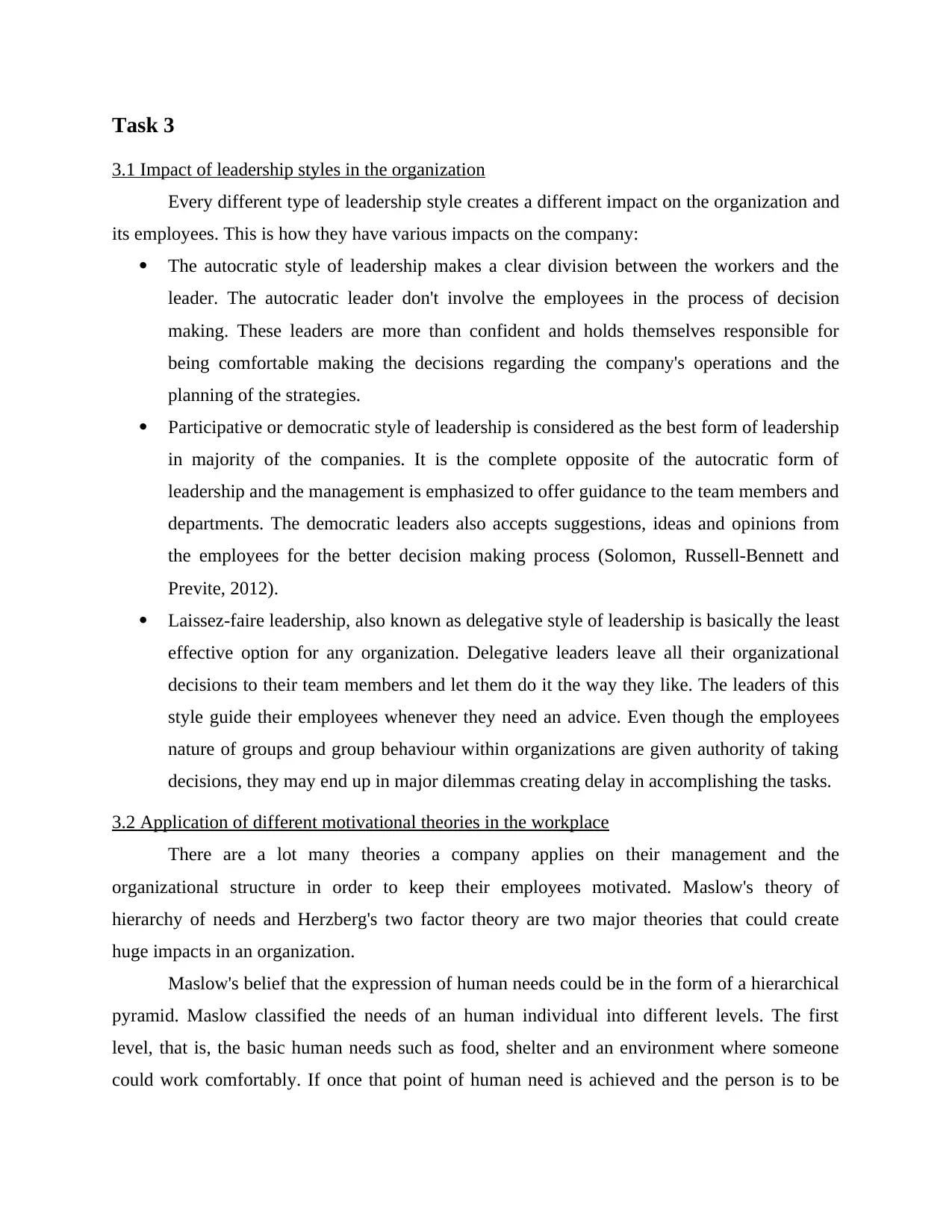
Task 3
3.1 Impact of leadership styles in the organization
Every different type of leadership style creates a different impact on the organization and
its employees. This is how they have various impacts on the company:
The autocratic style of leadership makes a clear division between the workers and the
leader. The autocratic leader don't involve the employees in the process of decision
making. These leaders are more than confident and holds themselves responsible for
being comfortable making the decisions regarding the company's operations and the
planning of the strategies.
Participative or democratic style of leadership is considered as the best form of leadership
in majority of the companies. It is the complete opposite of the autocratic form of
leadership and the management is emphasized to offer guidance to the team members and
departments. The democratic leaders also accepts suggestions, ideas and opinions from
the employees for the better decision making process (Solomon, Russell-Bennett and
Previte, 2012).
Laissez-faire leadership, also known as delegative style of leadership is basically the least
effective option for any organization. Delegative leaders leave all their organizational
decisions to their team members and let them do it the way they like. The leaders of this
style guide their employees whenever they need an advice. Even though the employees
nature of groups and group behaviour within organizations are given authority of taking
decisions, they may end up in major dilemmas creating delay in accomplishing the tasks.
3.2 Application of different motivational theories in the workplace
There are a lot many theories a company applies on their management and the
organizational structure in order to keep their employees motivated. Maslow's theory of
hierarchy of needs and Herzberg's two factor theory are two major theories that could create
huge impacts in an organization.
Maslow's belief that the expression of human needs could be in the form of a hierarchical
pyramid. Maslow classified the needs of an human individual into different levels. The first
level, that is, the basic human needs such as food, shelter and an environment where someone
could work comfortably. If once that point of human need is achieved and the person is to be
3.1 Impact of leadership styles in the organization
Every different type of leadership style creates a different impact on the organization and
its employees. This is how they have various impacts on the company:
The autocratic style of leadership makes a clear division between the workers and the
leader. The autocratic leader don't involve the employees in the process of decision
making. These leaders are more than confident and holds themselves responsible for
being comfortable making the decisions regarding the company's operations and the
planning of the strategies.
Participative or democratic style of leadership is considered as the best form of leadership
in majority of the companies. It is the complete opposite of the autocratic form of
leadership and the management is emphasized to offer guidance to the team members and
departments. The democratic leaders also accepts suggestions, ideas and opinions from
the employees for the better decision making process (Solomon, Russell-Bennett and
Previte, 2012).
Laissez-faire leadership, also known as delegative style of leadership is basically the least
effective option for any organization. Delegative leaders leave all their organizational
decisions to their team members and let them do it the way they like. The leaders of this
style guide their employees whenever they need an advice. Even though the employees
nature of groups and group behaviour within organizations are given authority of taking
decisions, they may end up in major dilemmas creating delay in accomplishing the tasks.
3.2 Application of different motivational theories in the workplace
There are a lot many theories a company applies on their management and the
organizational structure in order to keep their employees motivated. Maslow's theory of
hierarchy of needs and Herzberg's two factor theory are two major theories that could create
huge impacts in an organization.
Maslow's belief that the expression of human needs could be in the form of a hierarchical
pyramid. Maslow classified the needs of an human individual into different levels. The first
level, that is, the basic human needs such as food, shelter and an environment where someone
could work comfortably. If once that point of human need is achieved and the person is to be
⊘ This is a preview!⊘
Do you want full access?
Subscribe today to unlock all pages.

Trusted by 1+ million students worldwide
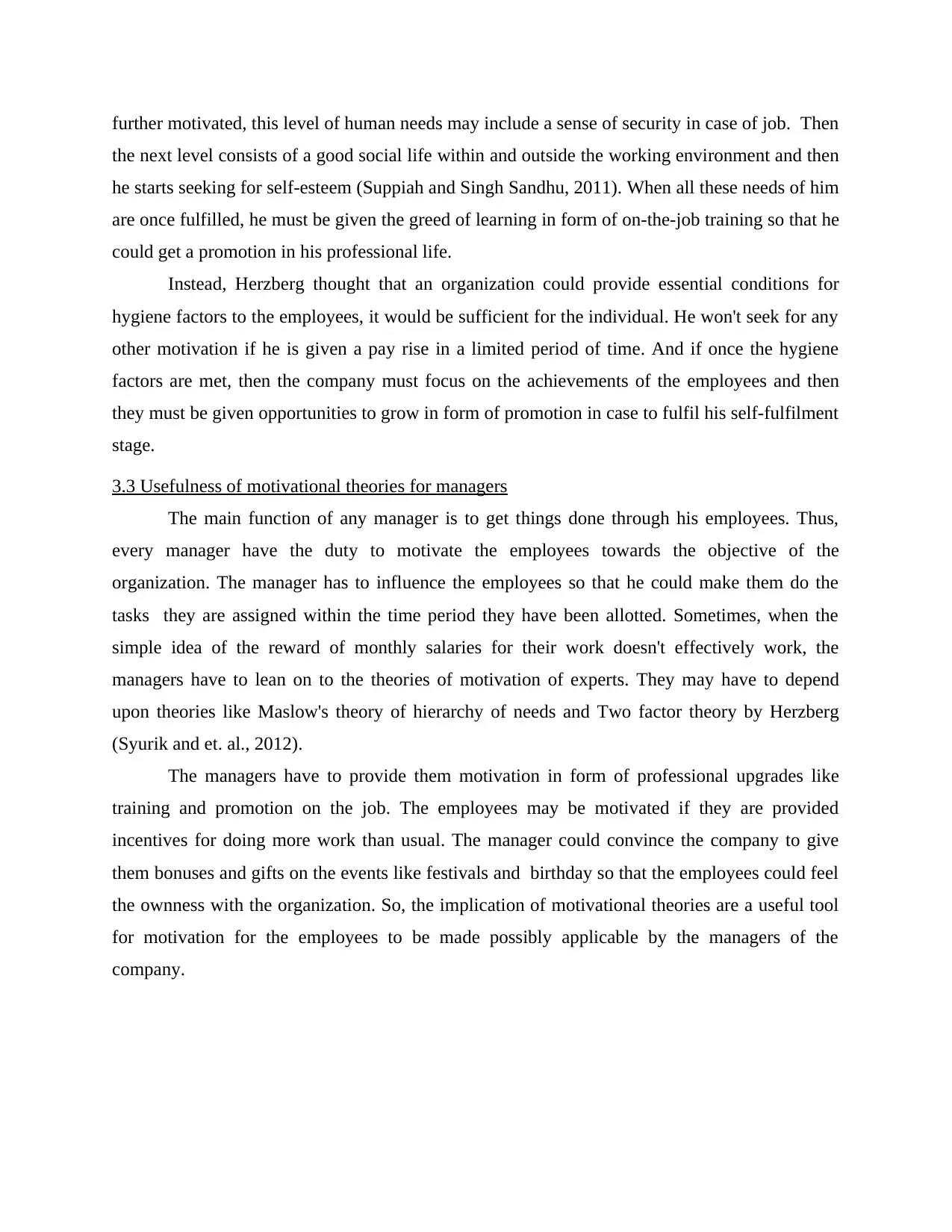
further motivated, this level of human needs may include a sense of security in case of job. Then
the next level consists of a good social life within and outside the working environment and then
he starts seeking for self-esteem (Suppiah and Singh Sandhu, 2011). When all these needs of him
are once fulfilled, he must be given the greed of learning in form of on-the-job training so that he
could get a promotion in his professional life.
Instead, Herzberg thought that an organization could provide essential conditions for
hygiene factors to the employees, it would be sufficient for the individual. He won't seek for any
other motivation if he is given a pay rise in a limited period of time. And if once the hygiene
factors are met, then the company must focus on the achievements of the employees and then
they must be given opportunities to grow in form of promotion in case to fulfil his self-fulfilment
stage.
3.3 Usefulness of motivational theories for managers
The main function of any manager is to get things done through his employees. Thus,
every manager have the duty to motivate the employees towards the objective of the
organization. The manager has to influence the employees so that he could make them do the
tasks they are assigned within the time period they have been allotted. Sometimes, when the
simple idea of the reward of monthly salaries for their work doesn't effectively work, the
managers have to lean on to the theories of motivation of experts. They may have to depend
upon theories like Maslow's theory of hierarchy of needs and Two factor theory by Herzberg
(Syurik and et. al., 2012).
The managers have to provide them motivation in form of professional upgrades like
training and promotion on the job. The employees may be motivated if they are provided
incentives for doing more work than usual. The manager could convince the company to give
them bonuses and gifts on the events like festivals and birthday so that the employees could feel
the ownness with the organization. So, the implication of motivational theories are a useful tool
for motivation for the employees to be made possibly applicable by the managers of the
company.
the next level consists of a good social life within and outside the working environment and then
he starts seeking for self-esteem (Suppiah and Singh Sandhu, 2011). When all these needs of him
are once fulfilled, he must be given the greed of learning in form of on-the-job training so that he
could get a promotion in his professional life.
Instead, Herzberg thought that an organization could provide essential conditions for
hygiene factors to the employees, it would be sufficient for the individual. He won't seek for any
other motivation if he is given a pay rise in a limited period of time. And if once the hygiene
factors are met, then the company must focus on the achievements of the employees and then
they must be given opportunities to grow in form of promotion in case to fulfil his self-fulfilment
stage.
3.3 Usefulness of motivational theories for managers
The main function of any manager is to get things done through his employees. Thus,
every manager have the duty to motivate the employees towards the objective of the
organization. The manager has to influence the employees so that he could make them do the
tasks they are assigned within the time period they have been allotted. Sometimes, when the
simple idea of the reward of monthly salaries for their work doesn't effectively work, the
managers have to lean on to the theories of motivation of experts. They may have to depend
upon theories like Maslow's theory of hierarchy of needs and Two factor theory by Herzberg
(Syurik and et. al., 2012).
The managers have to provide them motivation in form of professional upgrades like
training and promotion on the job. The employees may be motivated if they are provided
incentives for doing more work than usual. The manager could convince the company to give
them bonuses and gifts on the events like festivals and birthday so that the employees could feel
the ownness with the organization. So, the implication of motivational theories are a useful tool
for motivation for the employees to be made possibly applicable by the managers of the
company.
Paraphrase This Document
Need a fresh take? Get an instant paraphrase of this document with our AI Paraphraser
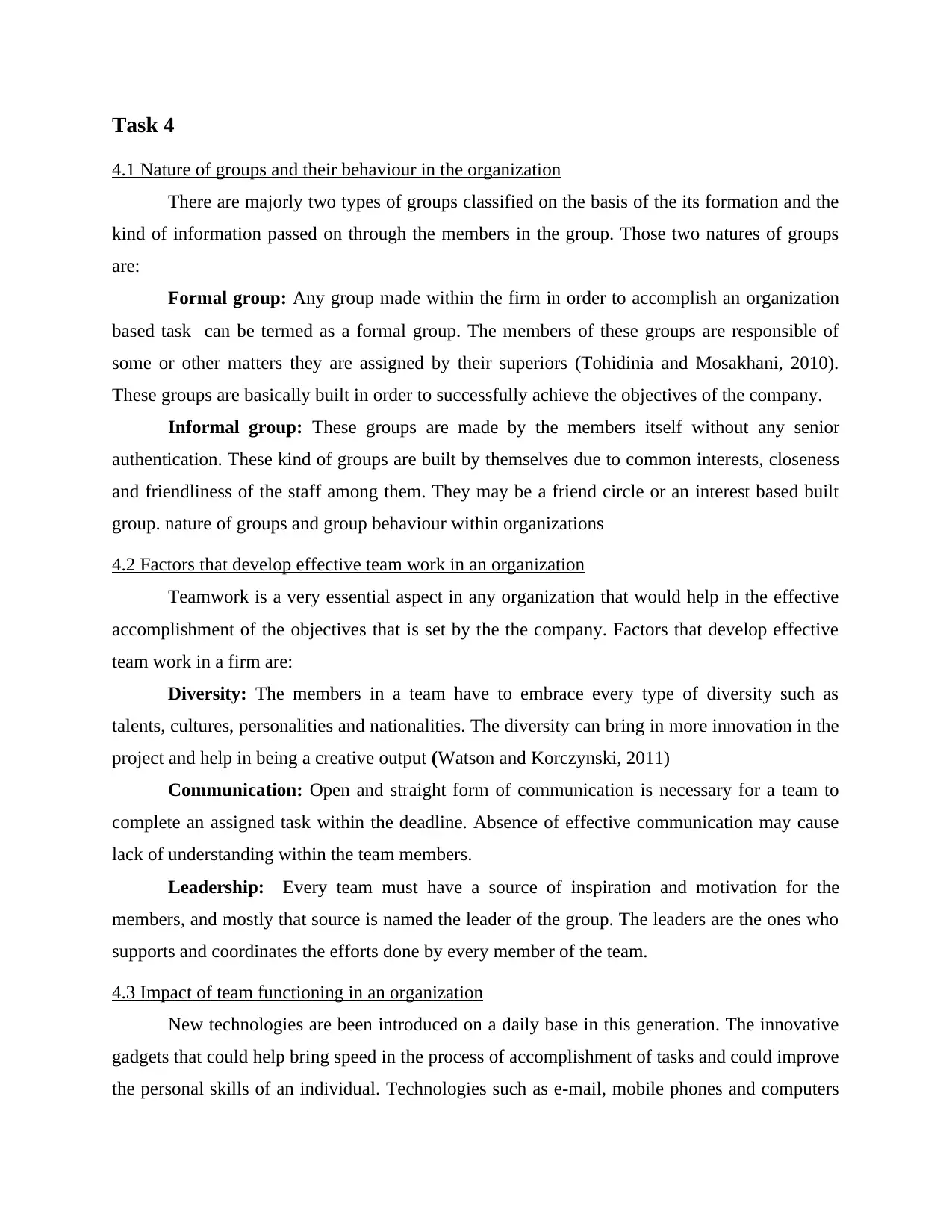
Task 4
4.1 Nature of groups and their behaviour in the organization
There are majorly two types of groups classified on the basis of the its formation and the
kind of information passed on through the members in the group. Those two natures of groups
are:
Formal group: Any group made within the firm in order to accomplish an organization
based task can be termed as a formal group. The members of these groups are responsible of
some or other matters they are assigned by their superiors (Tohidinia and Mosakhani, 2010).
These groups are basically built in order to successfully achieve the objectives of the company.
Informal group: These groups are made by the members itself without any senior
authentication. These kind of groups are built by themselves due to common interests, closeness
and friendliness of the staff among them. They may be a friend circle or an interest based built
group. nature of groups and group behaviour within organizations
4.2 Factors that develop effective team work in an organization
Teamwork is a very essential aspect in any organization that would help in the effective
accomplishment of the objectives that is set by the the company. Factors that develop effective
team work in a firm are:
Diversity: The members in a team have to embrace every type of diversity such as
talents, cultures, personalities and nationalities. The diversity can bring in more innovation in the
project and help in being a creative output (Watson and Korczynski, 2011)
Communication: Open and straight form of communication is necessary for a team to
complete an assigned task within the deadline. Absence of effective communication may cause
lack of understanding within the team members.
Leadership: Every team must have a source of inspiration and motivation for the
members, and mostly that source is named the leader of the group. The leaders are the ones who
supports and coordinates the efforts done by every member of the team.
4.3 Impact of team functioning in an organization
New technologies are been introduced on a daily base in this generation. The innovative
gadgets that could help bring speed in the process of accomplishment of tasks and could improve
the personal skills of an individual. Technologies such as e-mail, mobile phones and computers
4.1 Nature of groups and their behaviour in the organization
There are majorly two types of groups classified on the basis of the its formation and the
kind of information passed on through the members in the group. Those two natures of groups
are:
Formal group: Any group made within the firm in order to accomplish an organization
based task can be termed as a formal group. The members of these groups are responsible of
some or other matters they are assigned by their superiors (Tohidinia and Mosakhani, 2010).
These groups are basically built in order to successfully achieve the objectives of the company.
Informal group: These groups are made by the members itself without any senior
authentication. These kind of groups are built by themselves due to common interests, closeness
and friendliness of the staff among them. They may be a friend circle or an interest based built
group. nature of groups and group behaviour within organizations
4.2 Factors that develop effective team work in an organization
Teamwork is a very essential aspect in any organization that would help in the effective
accomplishment of the objectives that is set by the the company. Factors that develop effective
team work in a firm are:
Diversity: The members in a team have to embrace every type of diversity such as
talents, cultures, personalities and nationalities. The diversity can bring in more innovation in the
project and help in being a creative output (Watson and Korczynski, 2011)
Communication: Open and straight form of communication is necessary for a team to
complete an assigned task within the deadline. Absence of effective communication may cause
lack of understanding within the team members.
Leadership: Every team must have a source of inspiration and motivation for the
members, and mostly that source is named the leader of the group. The leaders are the ones who
supports and coordinates the efforts done by every member of the team.
4.3 Impact of team functioning in an organization
New technologies are been introduced on a daily base in this generation. The innovative
gadgets that could help bring speed in the process of accomplishment of tasks and could improve
the personal skills of an individual. Technologies such as e-mail, mobile phones and computers
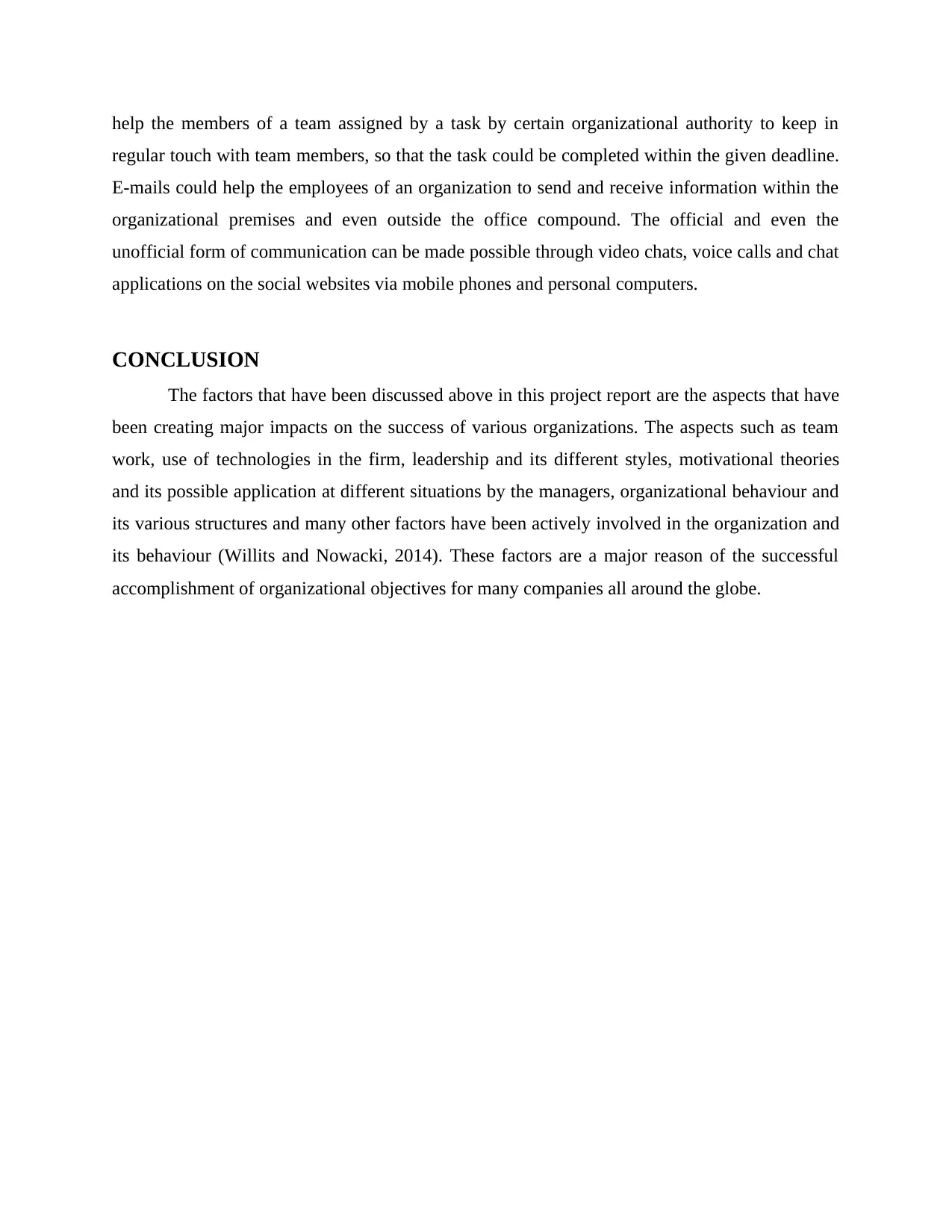
help the members of a team assigned by a task by certain organizational authority to keep in
regular touch with team members, so that the task could be completed within the given deadline.
E-mails could help the employees of an organization to send and receive information within the
organizational premises and even outside the office compound. The official and even the
unofficial form of communication can be made possible through video chats, voice calls and chat
applications on the social websites via mobile phones and personal computers.
CONCLUSION
The factors that have been discussed above in this project report are the aspects that have
been creating major impacts on the success of various organizations. The aspects such as team
work, use of technologies in the firm, leadership and its different styles, motivational theories
and its possible application at different situations by the managers, organizational behaviour and
its various structures and many other factors have been actively involved in the organization and
its behaviour (Willits and Nowacki, 2014). These factors are a major reason of the successful
accomplishment of organizational objectives for many companies all around the globe.
regular touch with team members, so that the task could be completed within the given deadline.
E-mails could help the employees of an organization to send and receive information within the
organizational premises and even outside the office compound. The official and even the
unofficial form of communication can be made possible through video chats, voice calls and chat
applications on the social websites via mobile phones and personal computers.
CONCLUSION
The factors that have been discussed above in this project report are the aspects that have
been creating major impacts on the success of various organizations. The aspects such as team
work, use of technologies in the firm, leadership and its different styles, motivational theories
and its possible application at different situations by the managers, organizational behaviour and
its various structures and many other factors have been actively involved in the organization and
its behaviour (Willits and Nowacki, 2014). These factors are a major reason of the successful
accomplishment of organizational objectives for many companies all around the globe.
⊘ This is a preview!⊘
Do you want full access?
Subscribe today to unlock all pages.

Trusted by 1+ million students worldwide
1 out of 14
Related Documents
Your All-in-One AI-Powered Toolkit for Academic Success.
+13062052269
info@desklib.com
Available 24*7 on WhatsApp / Email
![[object Object]](/_next/static/media/star-bottom.7253800d.svg)
Unlock your academic potential
Copyright © 2020–2025 A2Z Services. All Rights Reserved. Developed and managed by ZUCOL.





